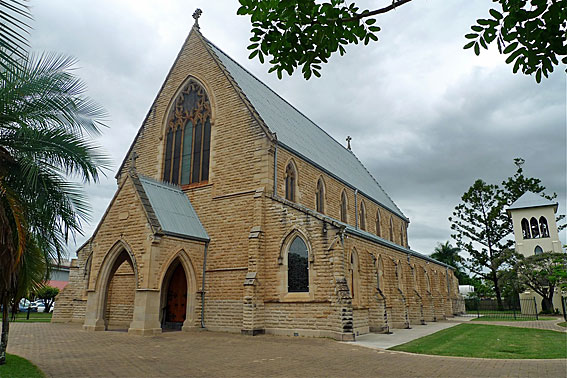
St Paul's Anglican Cathedral, Rockhampton
[Photograph by Trevor Bunning (November 2010)]

St Paul's Anglican Cathedral, Rockhampton
[Photograph by Trevor Bunning (November 2010)]
Historical and Technical Documentation by Geoffrey Cox
© OHTA 2010, 2012, 2017 (last updated April 2017)
Anglican services have been held in Rockhampton since the late 1850s, and the first St Paul's Church, a small timber building, was opened in 1862 while Rockhampton was still part of the Diocese of Brisbane. The present sandstone building, designed by architects Annersley Voysey and Frank Scarr, was opened and dedicated on 18 October 1883. With the separation of the Diocese of Rockhampton from the Diocese of Brisbane in 1892, St Paul's became the Cathedral.1
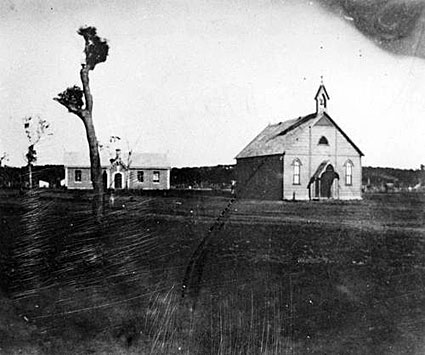
St Paul's Church of England and School, Rockhampton (1863)
[Photograph: John Oxley Library,
State Library of Queensland]
First Organ.
The first organ in the new church, built by Joshua Porritt of Leicester, was intended to arrive in time for the opening of the building in 1883. The order for the instrument had been placed by February 1882, when the following announcement appeared in the local press:
We understand that the Committee of St. Paul's Episcopalian Church, being in terms with an organist and choir master, have sent to England for a first-class organ. It will be furnished by Mr. John [sic.] Porritt, organ builder, Leicester, and will be a pipe organ with seventeen speaking stops, two manuals, and a great, swell, and pedal organs. It will be enclosed in an oak case with two fronts so as [to] fill the openings of the organ chamber, and will be a first-class instrument. A special fund was formed some time ago, and by means of a Bruce auction the sum of £25 was raised. It has since been augmented by three donations amounting to £35, and half-a-dozen gentlemen have each given a valuable piece of land, valued in the aggregate at £200. By means of a few more donations it is anticipated the fund will be sufficient to pay for the organ, and the tessellated pavement designed by Minton, for the aisles and chancel floors of the new church.2
But the passage of the instrument to the new church was thwarted when the ship carrying it was wrecked off the Queensland coast in July 1883. A later account from the 1930s provides some of the details:
It is not generally known that the beautifully-toned organ in the Cathedral was nearly lost at sea. It was brought from England by the sailing ship 'Deutschland' which was wrecked in July, 1883 on the Polmaise Reef, near Masthead Island, about 25 miles east of Cape Capricorn.
Captain C. Norris and a syndicate purchased the wreck and cargo, and on opening the hatches found about 20 cases containing the organ, which they sent to Rockhampton by the first boat bringing cargo from the wreck. It was fortunate that the organ was placed on top of the other cargo, which saved it from getting wet, as the water rose to within 10 ft of the top of the hold.3
The extent of the damage to the organ in the shipwreck was described variously in contemporary accounts. A report in The Brisbane Courier within a week of the disaster stated that the organ had not been saved:
ROCKHAMPTON, August 5, [1883].
The steamer Fitzroy returned from the wreck of the Deutschland on Saturday night with about £600 worth of cargo. The vessel now has her back broken, and has 5ft. 6in. of water in her hold. It is expected that all the cargo will be saved except the salt and gunpowder. The new organ for St. Paul's Church, which is on board the Deutschland, has not been saved.4
Other reports, however, state that the organ was salvaged successfully from the wreck: It had been loaded on top of the other cargo, which was auctioned on 28 July 1883, and salvaged as soon as possible. The instrument was reportedly installed in St Paul's in time for the opening of the church on 18 October 1883.5 An Australian correspondent writing shortly afterwards to the London periodical Musical Opinion, reported as follows:
In one of my former letters I informed you that our new organ, built by Mr. Porrit [sic.], of Leicester, had been wrecked on Masthead Reef, about eighty miles from Kepple Bay. The instrument was got off the wreck, but it was very much damaged by salt water. After its arrival in town the wreck committee sent it round to the new church building committee, who at once sent to a Mr. Christmas, an organ builder at Brisbane, to come and see whether he could make it usable. He made an inspection of the instrument, and said the sum of £200 was a fair value to be paid for it in its present state, which the wreck committee accepted. He also made an offer to the church building committee to do all necessary repairs, and to make it equal in all ways to what it was when it left England for the sum of £230.
Your humble servant and about nine hundred others attended the rehearsal, and I assure you that the whole of us were astonished at the splendid tones of the wrecked organ; and to listen to the people's praises about the music from it made one's heart glad to think that after all we had a good organ for our new church. . . . The singing of the choir, together with the sweet music from the organ, carried one's thoughts back again to dear old England.6
This was the only organ built by Joshua Porritt that is known to have come to Australia. The builder's brass plate provides some background information about this relatively little-known builder:
J. Porritt. Organ Builder. Leicester.
Finisher and Tuner of the Only Organ
in the South Kensington Exhibition
of 1862 which received the award
from the Musical Jury for
EXCELLENCE OF TONE.7
These details require further explanation: Joshua Porritt did not begin on his own as an organ builder until 1867, trading first as "J. Porritt", then as "J.Porritt & Son" and later as "Midland Counties Organ Works". At the 1862 Exhibition, it is recorded that the prize medal for "General Excellence of Tone," amongst other qualities, went to Henry Willis. It appears, therefore, that Porritt was employed by Willis at this time, and that he was "tonal finisher and tuner" of the 1862 organ.8
A detailed stop list of the Porritt organ in Rockhampton has not survived, but some sketchy details were recorded in 1933 by the Cathedral organist, Rev. E.R. Streeten, as follows:
... the organ is a two-manual instrument with the usual couplers. There are seven stops in the great organ and nine on the swell. The open diapason (8 ft.), the stopped diapason (8 ft.) and the Clarabella Flute (4 ft.) in the great organ and the Oboe and Horn on the swell are outstanding in beauty of tone, though the two latter are, owing to the exigencies of the climate, often doubtful quantities in the matter of intonation. The blower is now electric and there is always a full and sufficient supply of wind.9
It appears from later accounts that the organ originally had 16 speaking stops, 3 couplers and mechanical action, although it had been described in 1882 (see above as having seventeen speaking stops. Streeton's reference to "nine" stops on the swell may have included included the tremulant, and it is likely that some stop nomenclature mentioned by Streeton was later changed. The organ was driven by a hydraulic motor until the early 1920s,10 and an electric blower was supplied by Whitehouse Bros in June 1925 at a cost of £83.11
Streeton urged strongly in 1933 that the organ be rebuilt and its mechanism modernised.12 Five years later, the instrument was comprehensively rebuilt with tubular-pneumatic action by Whitehouse Bros of Brisbane at a cost of £720. The work included the specific addition of a Bass Flute stop,13 the complete replacement of the chests and action, the lowering of the organ's pitch, and the provision of a three-manual console in preparation for the addition of a choir organ. The latter was never to eventuate.
The rebuilt organ was dedicated on 15 May 1938, and an account of the instrument appeared in the Rockhampton press shortly afterwards:14
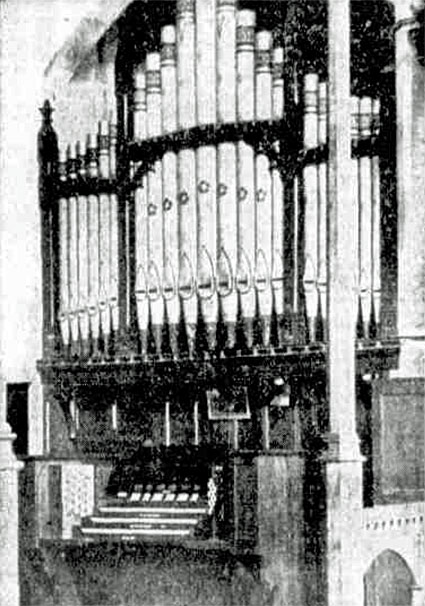
The 1883 Porritt organ, rebuilt with a three-manual console in 1938
by Whitehouse Bros, Brisbane
[Photograph: The Morning Bulletin (Rockhampton, 17 May 1938), p. 9.]
ORGAN AT ST PAUL'S CATHEDRAL
New Console With Three Manuals
Mechanism Rebuilt
By the installation of a new console, with three manuals, and, with the exception of the pipes, an entirely new mechanism, St Paul's Cathedral possesses an organ of outstanding quality, one that is recognised among the finest-toned instruments in the Commonwealth.
The original organ was installed in 1884 [sic.]; but although it retained beauty of tone, it was realised that its inner workings were out of date and that installation of modern mechanism was essential. This understanding was made possible by a bequest of £500 from the estate of the late Mr William Elleary.
The work of rebuilding was completed recently by Mr J. H. Whitehouse, of the firm of Whitehouse Bros, organ builders, Brisbane.
When asked to comment on the newly-constructed organ, Mr. Whitehouse said: "I consider the tone of this instrument compares more than favourably with other church organs in Australia. The organ now has an up-to-date action with a full complement of couplers and accessories, which will enable the organist to get the best out of the instrument.
Latest System
Mr Whitehouse also stated that the organ has been entirely rebuilt. The old mechanical action and slide soundboards had been discarded and the latest system of tubular pneumatic action installed.
The soundboards are slideless, with a separate pallet to each pipe. This ensures a full supply of wind and prevents "robbing". The pitch of the organ has been reduced from concert pitch, C540 to continental pitch C517. All the pipes were removed from the organ and treated individually for the removal of dirt, repairing, and the resetting of proper speech.
An additional 8 ft. flute stop has been placed on the pedal organ. Sub and super octave couplers have been added to the swell organ, also an octave coupler to the pedal organ.
An entirely new console has been fitted. It has full compass, CC to C, 61 notes. There are three manuals - swell, great, and choir organs - with a radiating and concave pedal board. Ten couplers and five pistons connect to the swell organ, five pistons to the great organ, and three pistons to the choir organ. There is a double-acting piston from the great to the pedal organ, on and off.15
The new three-manual detached console provided at Rockhampton in 1938 was in fact second-hand, having served previously at the First Church of Christ, Scientist, Darlinghurst, Sydney,16 where Whitehouse Bros rebuilt the J.E. Dodd organ with electro-pneumatic action in 1937.17 Repairs to the console at Rockhampton were carried out by Whitehouse Bros in March 1941.18
Apart from the addition of the Pedal Bass Flute stop and numerous couplers, the stop list of the rebuilt organ received little mention in the surviving records from 1938, and it can be assumed that there were no other additions. As has already been stated, however, the nomenclature of stops was almost certainly altered at this time. The following specification was recorded in the early 1950s:
| GREAT Bourdon Open Diapason Claribel Flute Dulciana Octave Harmonic Flute Fifteenth SWELL Open Diapason Rohr Flute Salicional Octave Suabe Flute Harmonic Piccolo Cornopean Oboe CHOIR [prepared for at the console only] PEDAL Major Bass Bass Flute COUPLERS Great to Pedal Swell to Pedal Swell to Great Swell Super Octave Swell Sub Octave Swell to Great Super Octave Swell to Great Sub Octave Swell to Choir Swell to Choir Super Octave Swell to Choir Sub Octave [? Pedal Octave] |
16 8 8 8 4 4 2 8 8 8 4 4 2 8 8 16 8 |
[1938] [1938] [1938] [1938] [1938] [1938] [1938] [1938] [1938] |
Swell tremulant
Detached drawstop console
Tubular-pneumatic action
Compass: 61/30
Pedalboard: radiating and concave
Balanced swell pedal
5 combination pistons to Great Organ
5 combination pistons to Swell Organ
3 combination pistons to Choir Organ.19
Having survived a shipwreck and been criticised for its unreliability, the old Porritt organ had lasted remarkably for 55 years before being completely rebuilt in 1938. It is a paradox that its tubular-pneumatic replacement lasted only a further 28 years before being removed and broken up in 1966, when an entirely new organ was installed. It is reported that the old instrument may have been one purchased in Maryborough around this time by Mr Robert Simpson, who was a onetime associate of the amateur organ-builder Noel Ferguson in Cairns. If so, it was allowed to deteriorate beneath Simpson's mother's house in Cairns, and was subsequently discarded.20
As late as 1974, the stencilled façade pipes of the Porritt organ were stored in the Cathedral's detached wooden bell tower, but the remainder of the organ had disappeared by this time.
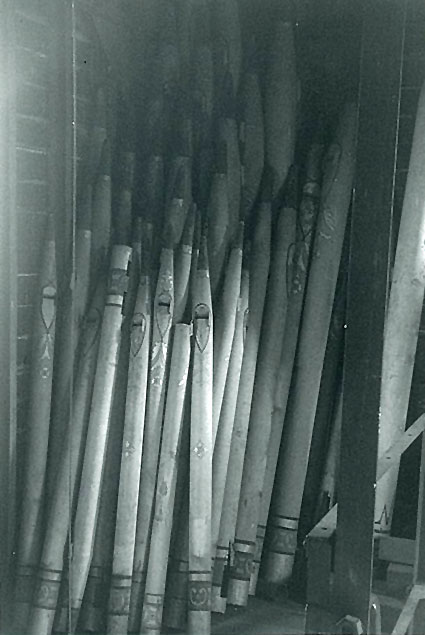
Façade pipes from the 1883 Porritt organ
stored in the bell tower at St Paul's Rockhampton
[Photograph by Geoffrey Cox (July 1974)]
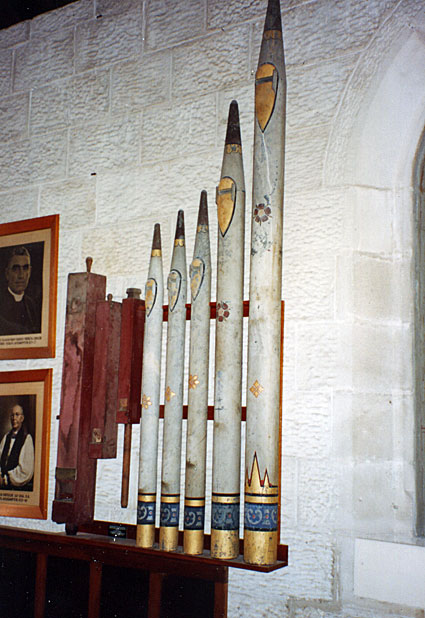
Façade pipes from the 1883 Porritt organ
[Photograph by Howard Baker (1990s)]
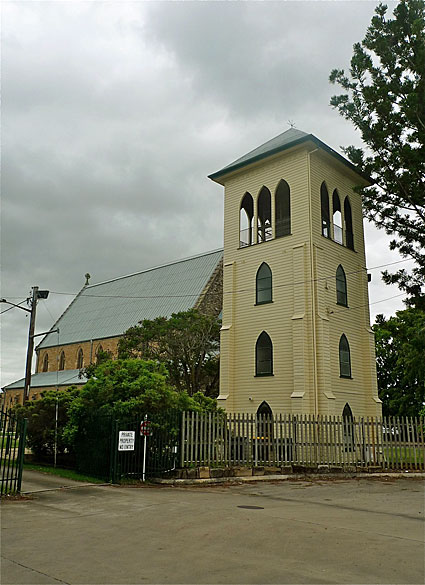
Detached wooden bell tower, St Paul's Cathedral, Rockhampton
where façade pipes of the Porritt organ were still stored as late as 1974
[Photograph by Trevor Bunning (November 2010)]
Present Organ.
The present organ was built in 1965 by J.W. Walker & Sons Ltd., Ruislip, UK, and installed in the Cathedral in 1966 by the firm's Australian manager, Mr Arthur Jones. It was first used on Easter Eve, 1966, and was dedicated at Solemn Evensong on 26 May 1966.21 Located on a raised platform beneath the window at the West end of the Cathedral, the instrument comprises 6 ranks extended over two manuals and pedals, with an independent Mixture. The Open Diapason and Stopped Diapason ranks on the Great and Pedal (ranks B and C below) are unenclosed, while the remaining pipework is under expression.
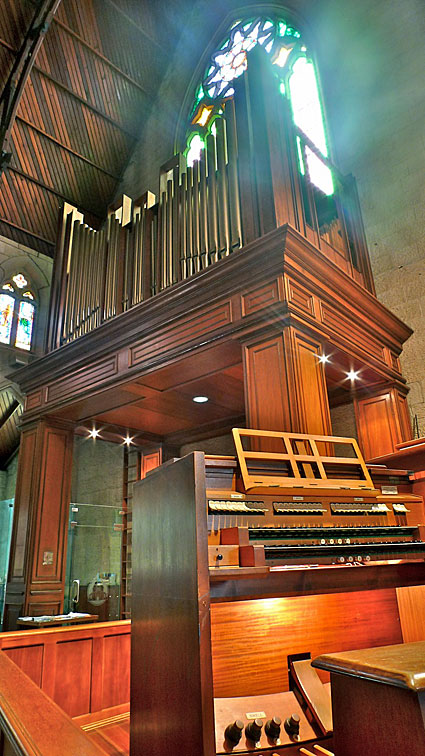
[Photograph by Trevor Bunning (November 2010)]

The present organ in St Paul's Cathedral, Rockhampton
[Photograph by Roger Marks (November 2010)]
| GREAT Contra Salicional Open Diapason Stopped Diapason Salicional Principal Stopped Flute Twelfth Fifteenth Trumpet SWELL Gemshorn Rohrflöte Salicional Gemshorn Flute Salicet Nazard Flautino Larigot Mixture Double Trumpet Trumpet Clarion PEDAL Bourdon Salicional Principal Bass Flute Salicet Fifteenth Octave Flute Trumpet COUPLERS Great to Pedal Swell to Pedal Swell to Great |
16 8 8 8 4 4 2-2/3 2 8 8 8 8 4 4 4 2-2/3 2 1-1/3 III 16 8 4 16 16 8 8 8 4 4 8 |
A B C A B C D D E D F A D F A F F F E [Ten.C] E E C A B C A B C E |
Detached Console
Tremulant
Direct electric action
Compass: 61/30
4 pistons to Swell Organ
4 pistons to Great Organ
4 toe pistons to Swell Organ
4 toe pistons to Pedal Organ
Balanced Swell Pedal
Double Touch Canceller
Great to Pedal Reversible Toe Piston
Great & Pedal combs coupled.22
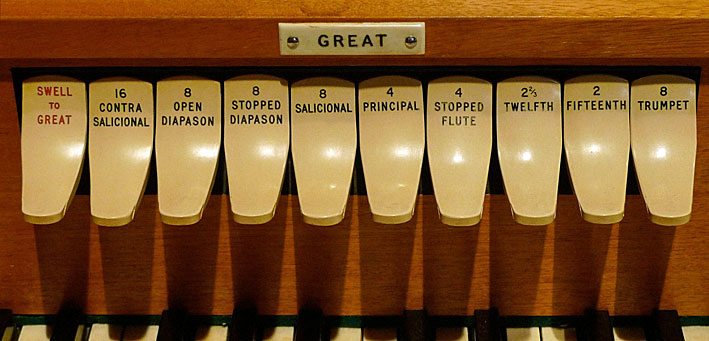
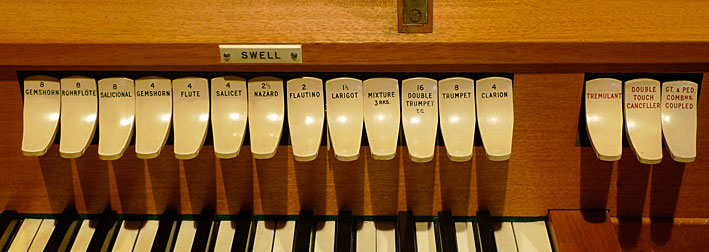
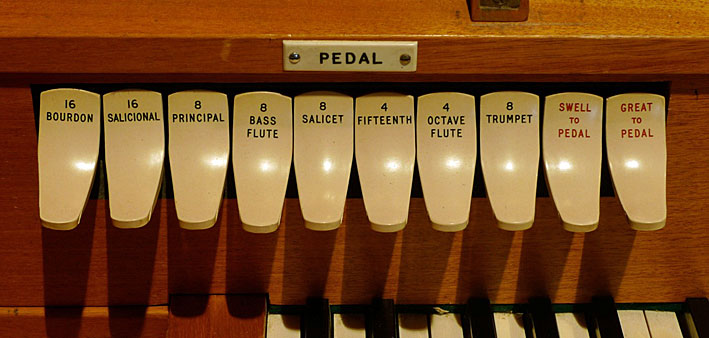
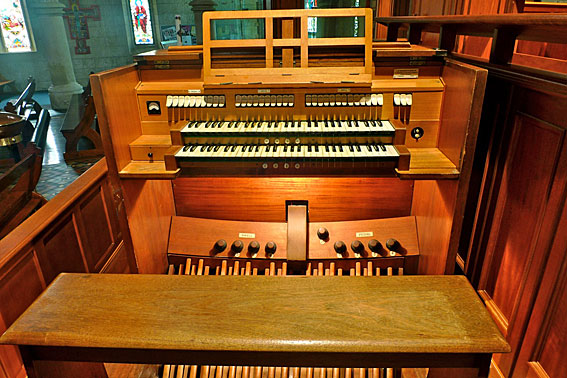
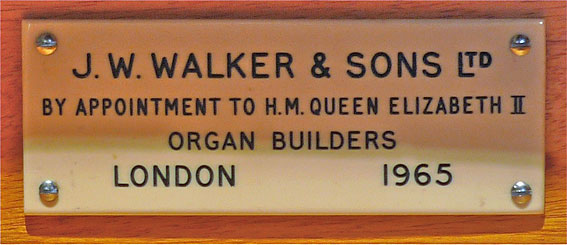
Console and Builder's Nameplate on the Present Organ in St Paul's Cathedral, Rockhampton
[Photographs by Trevor Bunning (November 2010)]
Following structural problems involving the wall at the West end of the Cathedral in March 2017, the building has been closed until further notice, and the Walker organ has become inaccessible. Services are being held within the Parish Hall until the situation can be rectified.23
___________________________________________________________________
1 Queensland Heritage Council, Queensland Heritage Register, location 600821; John Bayton, The Cathedral Church of Saint Paul the Apostle [St Paul's Cathedral Handbook: A History and Guide] (Rockhampton, Record Printing, 1970), pp. 8-11.
2 The Morning Bulletin (Rockhampton, 24 February 1882), p. 2; The Capricornian (25 February 1882), p. 10.
3 Jubilee Booklet (Rockhampton: St Paul's Cathedral, 1933), p. 31; reproduced in part in The Morning Bulletin (Rockhampton, 17 May 1938), p. 9.
4 The Brisbane Courier (6 August 1883), p. 5.
5 Unpublished family history of Erik Olsen (1858-91), a crewman on the 'Deutschland' in 1883, supplied to David Cahill by Glen Bartlett, c.2011.
6 Musical Opinion & Music Trade Review (1 April 1884), p. 318.
7 Builder's plate cited at Rockhampton, July 1974, courtesy of Very Rev. John Bayton, Dean of St Paul's Cathedral. Details also recorded by Robert Wallace, Lindfield, NSW, 1961, and provided in personal communication to G. Cox, 27 January 1973.
8 Personal communication to G. Cox from Rev. B.B. Edmonds, Banbury, Oxon, UK, 25 June 1974.
9 Jubilee Booklet (1933), op. cit.
10 Personal communication to G. Cox from John Villaume, c.1974.
11 Whitehouse Bros Ledger (1922-1940), p. 102.
12 Jubilee Booklet (1933), op. cit.
13 Whitehouse Bros Ledger (1922-1940), p. 320.
14 Plaque on the organ, cited by Robert Wallace, 1961.
15 The Morning Bulletin (Rockhampton, 17 May 1938), p. 9.
16 Personal communication to G. Cox from Robert Wallace, Lindfield, NSW, 27 January 1973, and from Whitehouse Bros, c.1974.
17 Whitehouse Bros Ledger (1922-1940), p. 437.
18 Whitehouse Bros Ledger (1940-1954), p. 270.
19 Collected Organ Specifications of Bernie Brohan (c.1952), with additional details drawn from The Morning Bulletin (Rockhampton, 17 May 1938), p. 9.
20 Personal communications to G. Cox from David Cahill, April 2011 and July 2012.
21 Bayton, op. cit., p. 36.
22 Specification noted by G. Cox, July 1974.
23 Personal communication to G. Cox from Roger Marks (Cathedral Organist Emeritus), March 2017.
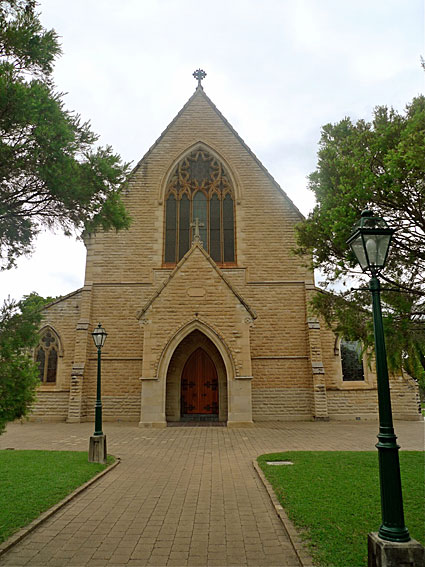
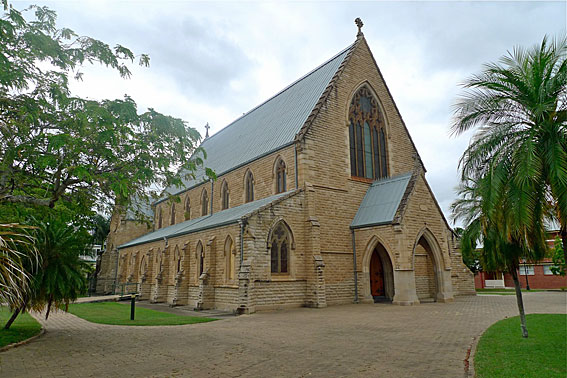
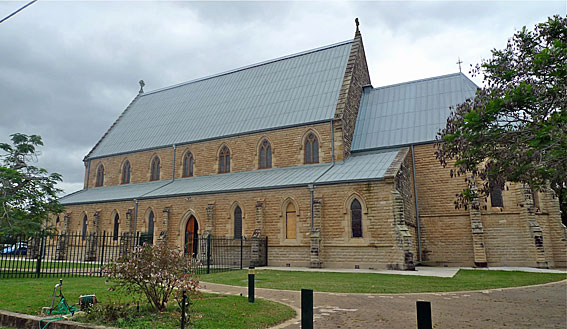
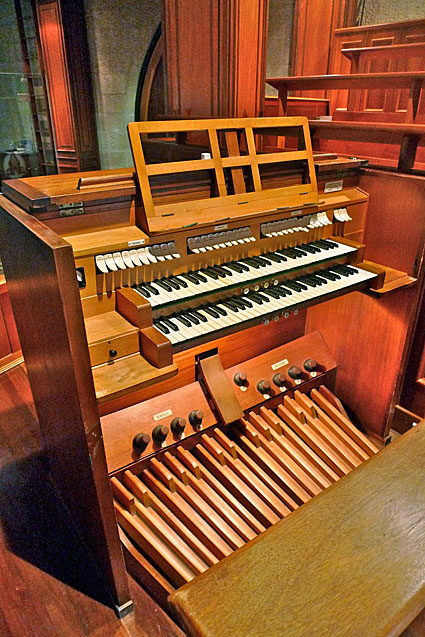
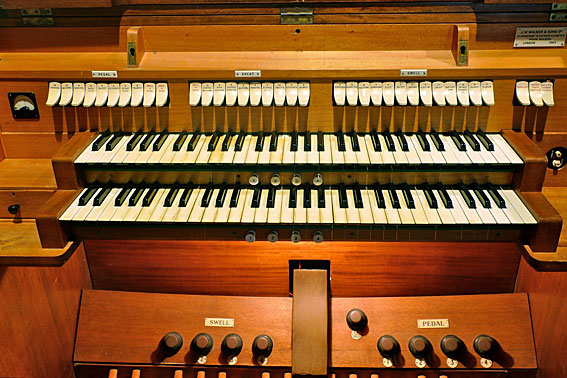
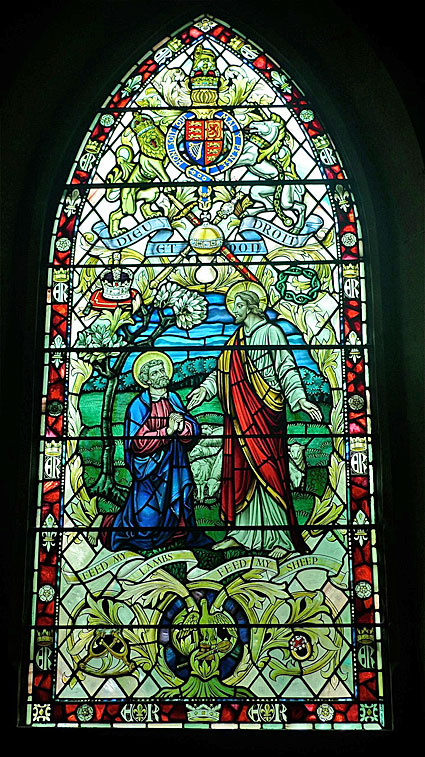
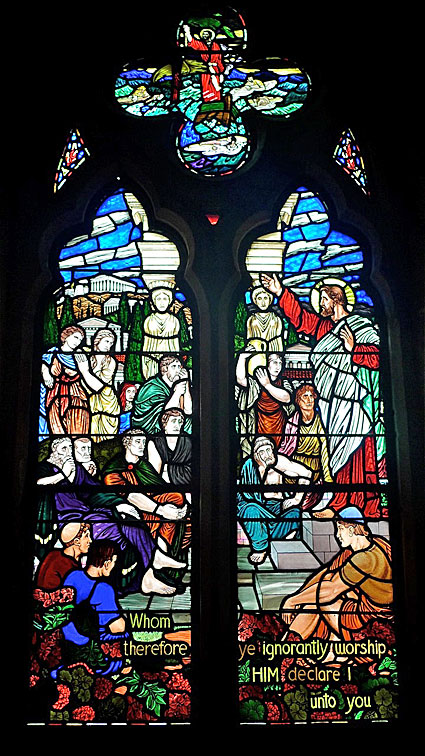
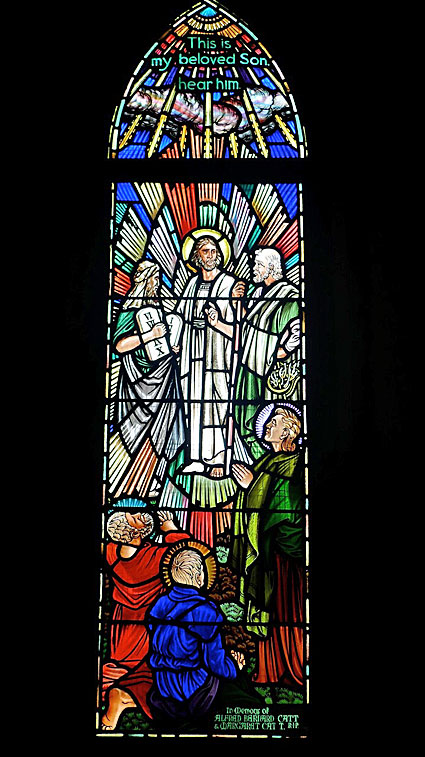
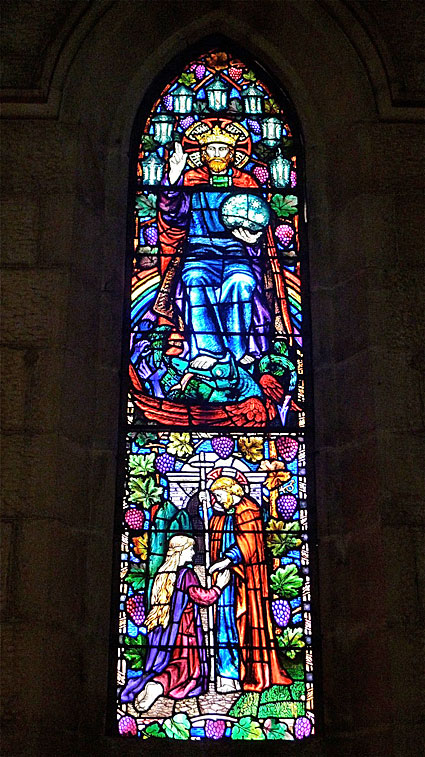
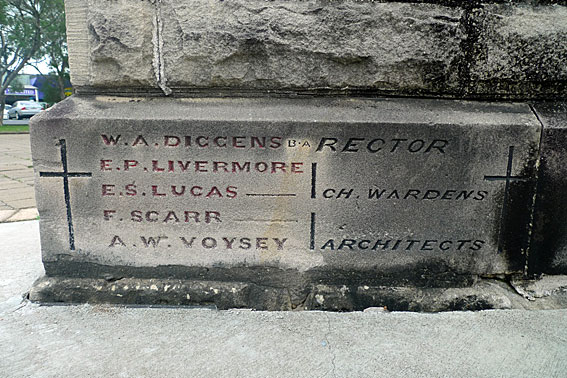
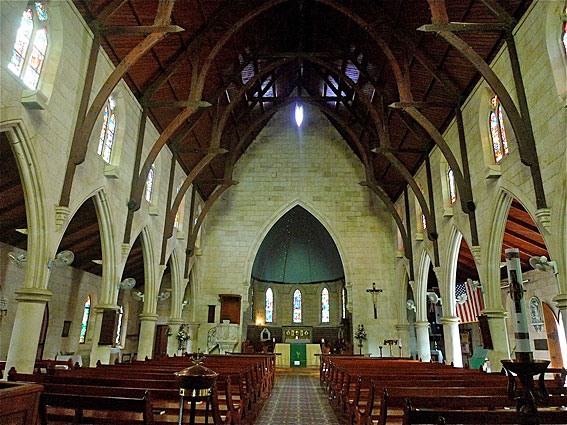
[Photographs by Trevor Bunning (November 2010)]